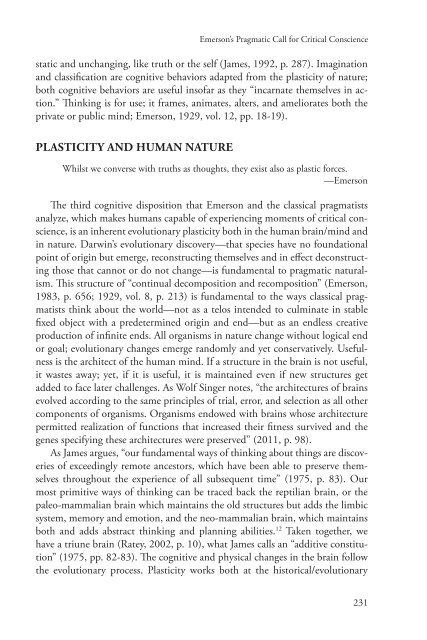Critical Expressivism- Theory and Practice in the Composition Classroom, 2014a
Critical Expressivism- Theory and Practice in the Composition Classroom, 2014a
Critical Expressivism- Theory and Practice in the Composition Classroom, 2014a
Create successful ePaper yourself
Turn your PDF publications into a flip-book with our unique Google optimized e-Paper software.
Emerson’s Pragmatic Call for <strong>Critical</strong> Conscience<br />
static <strong>and</strong> unchang<strong>in</strong>g, like truth or <strong>the</strong> self (James, 1992, p. 287). Imag<strong>in</strong>ation<br />
<strong>and</strong> classification are cognitive behaviors adapted from <strong>the</strong> plasticity of nature;<br />
both cognitive behaviors are useful <strong>in</strong>sofar as <strong>the</strong>y “<strong>in</strong>carnate <strong>the</strong>mselves <strong>in</strong> action.”<br />
Th<strong>in</strong>k<strong>in</strong>g is for use; it frames, animates, alters, <strong>and</strong> ameliorates both <strong>the</strong><br />
private or public m<strong>in</strong>d; Emerson, 1929, vol. 12, pp. 18-19).<br />
PLASTICITY AND HUMAN NATURE<br />
Whilst we converse with truths as thoughts, <strong>the</strong>y exist also as plastic forces.<br />
—Emerson<br />
The third cognitive disposition that Emerson <strong>and</strong> <strong>the</strong> classical pragmatists<br />
analyze, which makes humans capable of experienc<strong>in</strong>g moments of critical conscience,<br />
is an <strong>in</strong>herent evolutionary plasticity both <strong>in</strong> <strong>the</strong> human bra<strong>in</strong>/m<strong>in</strong>d <strong>and</strong><br />
<strong>in</strong> nature. Darw<strong>in</strong>’s evolutionary discovery—that species have no foundational<br />
po<strong>in</strong>t of orig<strong>in</strong> but emerge, reconstruct<strong>in</strong>g <strong>the</strong>mselves <strong>and</strong> <strong>in</strong> effect deconstruct<strong>in</strong>g<br />
those that cannot or do not change—is fundamental to pragmatic naturalism.<br />
This structure of “cont<strong>in</strong>ual decomposition <strong>and</strong> recomposition” (Emerson,<br />
1983, p. 656; 1929, vol. 8, p. 213) is fundamental to <strong>the</strong> ways classical pragmatists<br />
th<strong>in</strong>k about <strong>the</strong> world—not as a telos <strong>in</strong>tended to culm<strong>in</strong>ate <strong>in</strong> stable<br />
fixed object with a predeterm<strong>in</strong>ed orig<strong>in</strong> <strong>and</strong> end—but as an endless creative<br />
production of <strong>in</strong>f<strong>in</strong>ite ends. All organisms <strong>in</strong> nature change without logical end<br />
or goal; evolutionary changes emerge r<strong>and</strong>omly <strong>and</strong> yet conservatively. Usefulness<br />
is <strong>the</strong> architect of <strong>the</strong> human m<strong>in</strong>d. If a structure <strong>in</strong> <strong>the</strong> bra<strong>in</strong> is not useful,<br />
it wastes away; yet, if it is useful, it is ma<strong>in</strong>ta<strong>in</strong>ed even if new structures get<br />
added to face later challenges. As Wolf S<strong>in</strong>ger notes, “<strong>the</strong> architectures of bra<strong>in</strong>s<br />
evolved accord<strong>in</strong>g to <strong>the</strong> same pr<strong>in</strong>ciples of trial, error, <strong>and</strong> selection as all o<strong>the</strong>r<br />
components of organisms. Organisms endowed with bra<strong>in</strong>s whose architecture<br />
permitted realization of functions that <strong>in</strong>creased <strong>the</strong>ir fitness survived <strong>and</strong> <strong>the</strong><br />
genes specify<strong>in</strong>g <strong>the</strong>se architectures were preserved” (2011, p. 98).<br />
As James argues, “our fundamental ways of th<strong>in</strong>k<strong>in</strong>g about th<strong>in</strong>gs are discoveries<br />
of exceed<strong>in</strong>gly remote ancestors, which have been able to preserve <strong>the</strong>mselves<br />
throughout <strong>the</strong> experience of all subsequent time” (1975, p. 83). Our<br />
most primitive ways of th<strong>in</strong>k<strong>in</strong>g can be traced back <strong>the</strong> reptilian bra<strong>in</strong>, or <strong>the</strong><br />
paleo-mammalian bra<strong>in</strong> which ma<strong>in</strong>ta<strong>in</strong>s <strong>the</strong> old structures but adds <strong>the</strong> limbic<br />
system, memory <strong>and</strong> emotion, <strong>and</strong> <strong>the</strong> neo-mammalian bra<strong>in</strong>, which ma<strong>in</strong>ta<strong>in</strong>s<br />
both <strong>and</strong> adds abstract th<strong>in</strong>k<strong>in</strong>g <strong>and</strong> plann<strong>in</strong>g abilities. 12 Taken toge<strong>the</strong>r, we<br />
have a triune bra<strong>in</strong> (Ratey, 2002, p. 10), what James calls an “additive constitution”<br />
(1975, pp. 82-83). The cognitive <strong>and</strong> physical changes <strong>in</strong> <strong>the</strong> bra<strong>in</strong> follow<br />
<strong>the</strong> evolutionary process. Plasticity works both at <strong>the</strong> historical/evolutionary<br />
231


















